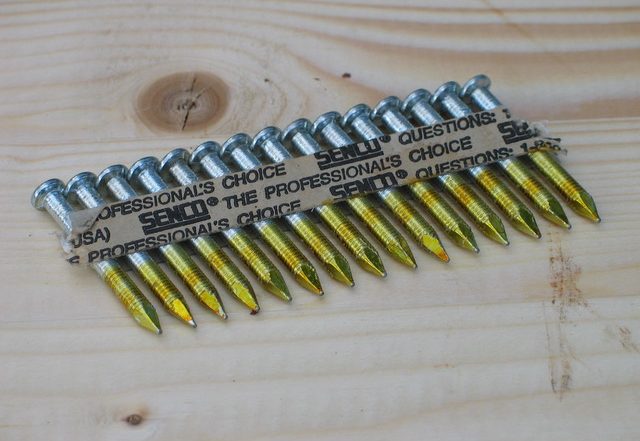Differences in complications between a hammer and a pneumatic nail gun.
A 45-year-old construction worker presents to the emergency department with a pneumatic nail gun injury to the hand. This occurred immediately prior to arrival at the emergency department. He has a limited range of motion of the fifth digit, predominantly at the MCP. Each digit has a brisk cap refill noted.
Below is a photograph of his injury and the associated radiographs.

Which of the following is a complication specific to pneumatic nail gun injuries as compared to nail injuries from a standard hammer?
Question Answer Choices
- Infection
- Joint space violation
- Retained foreign body after nail extraction
- Tendon laceration
- Tetanus exposure
Correct answer: C. Retained foreign body after nail extraction
The clips of nails for pneumatic nail guns are held together with paper, glue and occasionally copper wires. As such, these nails often carry debris with them on their trajectory and have a higher rate of wound contamination with foreign bodies than traditionally hammered, individual nails. The photograph below shows a typical configuration of a nail gun clip, in which the nails are held together by paper/glue. Another typical configuration holds the nails together with a thin filament of wire.
Bedside antegrade extraction may be appropriate for either pneumatic nail gun injury or standard, hammered nail injury. The decision to extract the nail at the bedside rather than the operating room should be made in consultation with a surgeon. These are typically removed antegrade to avoid additional damage from barbs present on the nail when removing the nail in retrograde.
Although bedside removal of simple impalements without bony, joint, tendon or neurovascular complications may be appropriate, surgical consultation for operative intervention is necessary for more complicated injuries.
Incorrect answer choices:
Infection (Choice A) is possible after injury from nails secondary to pneumatic nail guns and standard hammers.
Joint space violation (Choice B) and tendon laceration (Choice D) are not unique features of a pneumatic nail gun injury. In fact, one series reported that only 25% of pneumatic nail gun injuries resulted in structural damage.
Tetanus exposure (Choice E) is a risk with any violation of the skin. Pneumatic nail gun nails are no more likely to carry tetanus spores than a hammered nail. This patient’s tetanus vaccination status should be updated if needed.



